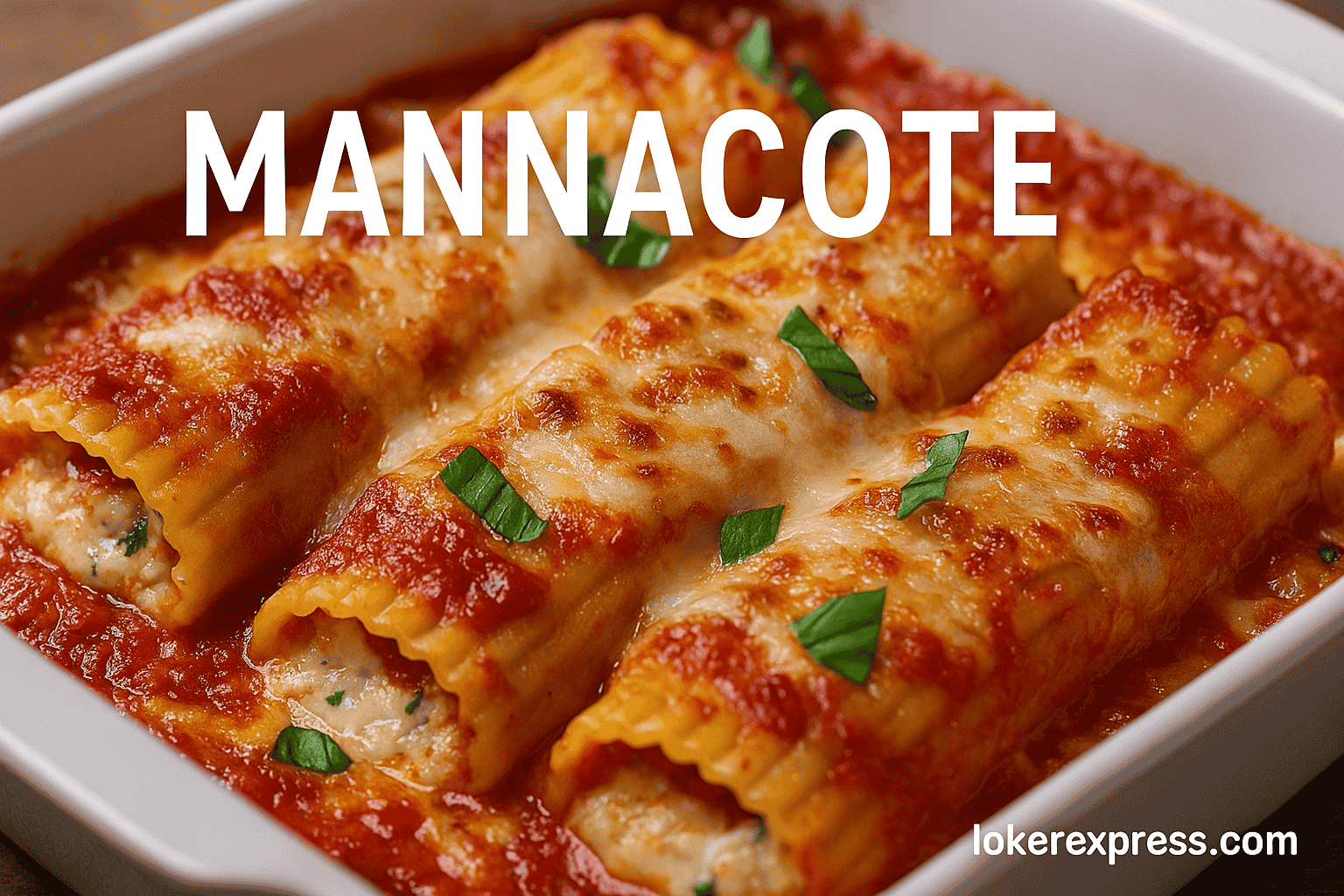What is Mannacote? A Delicious Twist on an Italian Classic
Mannacote, often considered a stylized spelling or regional variation of manicotti, is a pasta dish that has stolen the hearts of countless food lovers. At its core, mannacote refers to large pasta tubes that are filled with rich, creamy cheese mixtures—typically ricotta, mozzarella, and Parmesan—then covered in sauce and baked until bubbly and golden. It’s an indulgent, comforting recipe that sits somewhere between lasagna and stuffed shells in terms of flavor and experience.
While some argue over the correct pronunciation or spelling, what’s undeniable is how satisfying and hearty this dish can be. Whether you’re cooking for a weeknight family dinner or preparing something impressive for a gathering, mannacote always hits the mark. It’s not just a meal; it’s a celebration of warmth, love, and indulgence in every bite.
The History Behind Mannacote (Manicotti)
To truly appreciate mannacote, we need to dive into the roots of manicotti, which translates from Italian as “little sleeves.” This name comes from the tube-shaped pasta used in the dish, traditionally filled with various cheeses and herbs. In Italy, the original dish is closely related to cannelloni, another filled pasta, though manicotti is more common in Italian-American cooking.
As Italian immigrants settled in the United States, they brought with them rich culinary traditions. Over time, the recipes evolved based on available ingredients and local preferences. Mannacote reflects this journey. It’s not uncommon for older family recipes to use different spellings like “mannacote,” particularly in hand-written cookbooks and regional communities. This version often incorporates heavier cheeses and thicker sauces, aligning with the American love for bold, rich flavors.
Essential Ingredients That Make Mannacote Irresistible
The charm of mannacote lies in its simplicity combined with quality ingredients. Here’s what typically goes into a delicious tray of mannacote:
- Pasta Tubes: The base of the dish, manicotti pasta tubes (or even homemade crepes in some traditional recipes) provide the vessel for the filling.
- Cheese Filling: A combination of ricotta, shredded mozzarella, Parmesan cheese, egg (for binding), garlic, parsley, and seasoning creates the creamy interior.
- Tomato Sauce or Béchamel: Most classic versions use marinara or tomato sauce, but some modern takes use a white béchamel sauce for a luxurious twist.
- Toppings: More cheese—especially mozzarella or even provolone—is added on top for a bubbly, golden finish.
The magic comes from the balance of flavors: savory, tangy tomato sauce against mild, creamy cheese all encased in tender pasta.
Step-by-Step Preparation of Mannacote at Home
Making mannacote may look intricate, but it’s surprisingly approachable with the right steps:
- Boil the Pasta: Cook the pasta tubes al dente. You want them firm enough to hold their shape while being pliable for stuffing.
- Mix the Filling: Combine ricotta, mozzarella, Parmesan, eggs, herbs, and spices. Mix until smooth and creamy.
- Prepare the Sauce: Use a pre-made marinara or make your own by simmering tomatoes with garlic, onions, and Italian herbs.
- Stuff the Tubes: Use a piping bag or spoon to fill each manicotti tube generously with the cheese mixture.
- Layer and Assemble: Spread sauce at the bottom of a baking dish, line up the stuffed tubes, cover with more sauce and shredded cheese.
- Bake: Cover with foil and bake at 375°F for about 30 minutes. Remove foil and bake another 10 minutes for a golden top.
- Rest and Serve: Let it sit for 5–10 minutes before serving for better texture and flavor distribution.
Popular Mannacote Variations Across Kitchens
One of the joys of mannacote is how adaptable it is to various tastes. Here are a few popular variations:
- Meat-Filled Mannacote: Add seasoned ground beef, sausage, or shredded chicken to the cheese filling for added depth and protein.
- Vegetarian Delight: Incorporate spinach, mushrooms, or roasted peppers into the filling for a veggie-packed version.
- White Sauce Mannacote: Swap out tomato sauce for creamy béchamel or Alfredo for a decadent twist.
- Gluten-Free Version: Use gluten-free manicotti shells or even thin slices of eggplant or zucchini as pasta alternatives.
- Spicy Mannacote: Add red chili flakes or a spicy arrabbiata sauce for a dish with a kick.
These variations ensure that mannacote can be tailored to fit almost any dietary preference or occasion.
Tips for Perfect Mannacote Every Time
Even though it’s a forgiving dish, a few kitchen tips can elevate your mannacote to professional levels:
- Don’t Overcook Pasta: Slightly undercook the pasta since it will continue baking in the oven.
- Drain Ricotta Well: Use a cheesecloth or fine sieve to drain excess water from ricotta, ensuring the filling isn’t runny.
- Use Fresh Herbs: Fresh parsley and basil enhance flavor much more than their dried counterparts.
- Layer Generously: Don’t skimp on the sauce and cheese layers—they’re essential for moisture and richness.
- Let It Rest: Resting after baking allows flavors to settle and makes serving easier.
What to Serve with Mannacote: Side Dish Ideas
Pairing mannacote with the right sides elevates it from a great dish to a complete meal. Consider these additions:
- Garlic Bread: Crispy, buttery garlic bread is a classic companion to mop up any leftover sauce.
- Green Salad: A fresh arugula or Caesar salad balances the richness of the pasta.
- Roasted Veggies: Seasonal vegetables like zucchini, carrots, or asparagus provide color and nutrition.
- Wine Pairing: A bold red wine like Chianti or Zinfandel complements the robust flavors of the dish beautifully.
How to Store and Reheat Mannacote
Got leftovers? Great—mannacote often tastes even better the next day. Here’s how to store and reheat it properly:
- Refrigerator: Place cooled leftovers in an airtight container. It’ll last up to 3–4 days in the fridge.
- Freezer: For longer storage, freeze individual portions wrapped in plastic wrap and foil. It can last up to 2 months.
- Reheating: In the oven, cover with foil and bake at 350°F until heated through (20–25 minutes). In the microwave, heat in short bursts to avoid drying out.
The Cultural Appeal of Mannacote in Modern Kitchens
Mannacote isn’t just a dish—it’s a cultural staple in many households. It symbolizes comfort, family gatherings, and homemade love. The adaptability of the recipe has allowed it to remain relevant in contemporary kitchens while still evoking the nostalgic warmth of home-cooked meals.
Food bloggers, home cooks, and chefs continue to reinvent mannacote with unique twists, making it a standout dish for casual weeknights or elegant dinners. Its reputation as a “feel-good” food has only grown, amplified by its visual appeal and deep, comforting flavors.
Read More: The Rise of Calamariere: A New Star in Global Seafood Trends
Conclusion: Why You’ll Crave Mannacote Every Week
Mannacote (or manicotti, if you prefer the classic spelling) is more than just pasta—it’s a creamy, cheesy, oven-baked masterpiece. Its satisfying texture, robust flavor, and endless customizations make it a staple in both traditional and modern kitchens. Whether you’re a beginner looking to try a new comfort food or a seasoned home chef perfecting your favorite recipe, mannacote has a place on your table.
With a balance of creamy cheese, flavorful sauce, and perfectly baked pasta, it’s no wonder this dish is one you’ll find yourself craving week after week.

